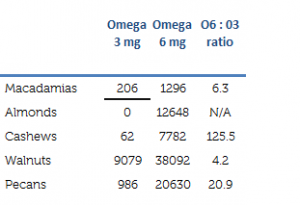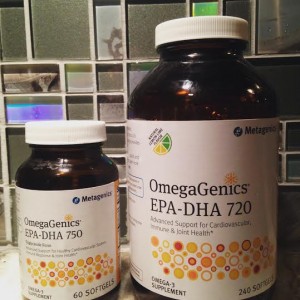I may never eat walnuts again…Here’s why!
No wonder Energy Fitness clients & most of the population are confused about nutrition & specifically fats. Having Metagenics (clinical based supplement company) as our partner helps us understand how to help our clients & you to achieve optimal nutrition & wellness.
By the end of this article we hope that you will have gained a greater understanding on fats and which nuts are better for and why. Balancing the good and bad fats can help increase your overall cellular health by a bio marker called Phase Angle. We measure phase angle and numerous other bio markers onsite with our our BIA machine (bioelectrical analysis).
Currently, most people understand the differences between the good (unsaturated fat), bad (saturated fat) and ugly (trans-fat) fats. Oils derived from animal fat are not good for our health due to their high levels of saturated fat and cholesterol, and that oils derived from plants are generally good for our health due to their unsaturated fat content. However, not all unsaturated fats are healthy. Many plant seed oils such as sunflower, peanut and corn oil are rich in inflammatory polyunsaturated fatty acids (PUFAs) and devoid of anti-inflammatory PUFAs.
On the other hand, some plant seed oils such as olive oil, grape seed, and avocado have balanced PUFAs and are considered healthier. Therefore, it is important to distinguish between the types of PUFAs in dietary oils for optimal health. Notice I didn’t include canola oil in the plant seed oils as popularly believed to be healthy. Did you know it’s typically extracted and refined using high heat, pressure, and petroleum solvents such as hexane. Most canola oil undergoes a process of caustic refining, degumming, bleaching, and deodorization, all using high heat and questionable chemicals. Even worse, all of this high heat, high pressure processing with solvents actually forces some of the omega-3 content of canola oil to be transformed into trans fats.
The basics: Omega-3 and Omega-6 are two types of polyunsaturated fatty acids. They are both required for the body to function but have opposite effects when it comes to the inflammatory response and cardiovascular health. Omega 3’s and are anti-inflammatory & Omega 6’s and are inflammatory. Omega 3’s & 6’s compete with electrolytes (sodium & potassium) to get inside the cells. Too much Omega-6 and too little Omega-3 are among the causes for many diseases in modern society.
A healthy diet should contain a balanced Omega-6:Omega-3 ratio of about 1:1. The standard American diet (SAD) exhibits Omega-6:Omega-3 ratios ranging between 15:1 to 17:1. Americans get almost 70% of their PUFA (mostly omega-6) from oils, shortening, and margarine and just 6% from beans, seeds, and nuts, 1% from eggs, and 13% from meat, poultry, and fish. So when we talk about Omega-6 intake, we’re really talking about french fries (cooked in vegetable oil), packaged pastries (made with shortening), and processed, high-sugar, high-(vegetable)fat junk food intake. Epidemiology and dietary intervention studies have concluded that while an exceptionally high Omega-6:Omega-3 ratio promotes the development of many chronic diseases, a reduced Omega-6:Omega-3 ratio can prevent or reverse these diseases. Just eating some salmon, sardines, mussels, and pasteurized eggs can undo a lot of the damage.
Now that you have brushed up on the difference between the ratios of fat you will understand my statement of why I may never eat Walnuts again.

Since all these nuts have much more Omega 6 than Omega 3, we want to choose nuts that have relatively low amounts of PUFAs in order to limit the Omega 6 / Omega 3 imbalance we are exposed to. From the chart above you can see that the least Omega 3/6 imbalance risk is in macadamias, with only 1.5% coming from PUFA’s, and almost 60% from monounsaturated fats! The second best would be cashews and almonds. Walnuts have the worst Omega 6 / Omega 3 imbalance. Ironically, walnuts have the best Omega 3 : Omega 6 ratio and cashews have the worst ratio, but walnuts are the worst in terms of Omega 3 / 6 imbalance. The Omega 3 : 6 ratio does not have much significance when comparing nuts because none of these nuts have what we consider a “good” Omega 3 : Omega 6 ratio (i.e., at least 1:2). Although walnuts do contain a bit more Omega 3 than other nuts, they are also 47% PUFAs, and therefore contain over 5 times more Omega 6’s than cashews. That means you would have to eat a lot of foods high in Omega 3 fatty acids just to counteract the inflammatory effects of walnuts.
For all you calorie counters out there I have included the chart below so you can see micro-nutrients for 5 nuts so you can add appropriate amounts to your diet based on your metabolism and activity level. Nuts not listed that aren’t really nuts but seeds that also have good ratios are flax and chia seeds.
Not a client? Live in town and interested in our personal training or nutrition coaching? Click here for a FREE Consult (value $87) or give us a call at 901-466-6242
Check out our customized online training ($40-$80) here: Online Customized Training
Interested in our Massage or Body Wraps? Click here.
Energy Fitness, 552 South Main Street, Memphis, TN 38103







